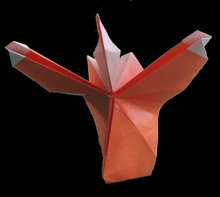
So, we will take care now of Directionality, Double Face, Smoothness and Porosity, all affected in a direct way by the productive processes in paper making.
Directionality

This is one of the main characteristics on papermaking. Due to the fact that pulp moves in a fitted direction in shaking, beating and production lines, the fibres get aligned in a Main Direction or Grain Direction (the flux one), affecting most of the mechanical properties of paper, such as Tensile Strength, fold elasticity, form and propagation of tears and many others. Also folding, marking and punching are done easily in this axial direction. It is so important for box making, packing and forming industries that it is indicated in cardboard packages; in case of rolls this direction is obvious.

To determine the Grain Direction the easiest way is to observe the natural bending of the sheet in different directions, holding it in one of its edges, here an example with a square of bond printing sheet


the Grain Direction offers a resistance to bending greater than the Cross Direction.
Another way to know it is observing the curling of paper when hydrated, fibres expands greater in its axial direction than the cross one, producing an abnormal and oriented deformation of the sheet, as you can see in these old books victims of humidity:


Finally, other tests to obtain it are more destructive and includes the measurement of tensile strnght (greater in the MD) or the rupture line of cracks when bursting (paradoxically perpendicular to Grain Direction)
We will talk a little more of this when we faces the mechanical properties in next entries but, as an example, if we get a kraft sheet of of 90 (g/m2) paper that, as we saw before, is a chemically processed paper, which preserves the fibres almost undamaged, we could see that its tensile strength is 7.43 (kN/m) in MD and 3.81 (kN/m) in its Cross Direction. Similar differences can be seen in many other properties, as foldability, tear propagation and others we will see.Double Face
Also due to papermaking processes, the pulp is moved in its line of production through bands with metallic grids, which affects the concentration of elements in one surface and the opposite, more in contact with poles and rolls. It's possible to show a distribution of components along the z-axis (or thickness axis) of the sheet, been the main affected fine and fillers.
The Grid side is called the Wire Side and the one in contact with poles the Felt Side. The first graph shows the ash concentration, which is normally used as a filler, and the second one the Resistance to filtration, greater in the presence of fine, meaning that paper absorbs less in the Felt Side than in the Wire Side, affecting inking and coating.
To identify one side from the other is important to know that there are surface differences, the grid leaves marks (squares or diamonds), sometimes visible at counterlight, you can use light carbon pencils or markers also. In adittion, Felt Side normally shows a closer formation and greater softness and smoothness than Wire Side.
Another method is to make a tear holding one side against a glass or a rigid surface, first in the MD and then changing to the CD (for example in a corner of the paper); when the Wire Side is up, the tear (specially on the curve area) shows a greater feathering; finally, if paper contains an abrasive filler, marking a line with a silver coin will live a darker mark on the Felt Side.
Double Face affects directly in the best suited type of fold and their resistance, Felt Side is denser and then it resist more the valley folds (compression) than the mountain (expansion), among other characteristics.
Smoothness
Smoothness is a surface property and in general has a greater influence in the mechanical use of paper, writing and manipulating than for folding and forming, however, aesthetic effects are important and also the presence of coating to improve surfaces affects on folding. There are several methods to measure smoothness, as optical analysis with light, the use of microscopes and micrometers, the pass of air trough paper and glass, friction against metal or other paper or inking with roll are also used.
Porosity
Porosity is a vital factor in paper composition, one must consider that paper is 50% air, some of it is inside fibres, but most of it is in the pores between them and its components. The rate between pore volume and total is called porosity. But it is only measured in laboratories, tha value normally measured is air permeability, which is basically the flux of air that passes at pressure trough a sheet of paper, or its inverse, the resistance to the pass of air. These parameters are related, but very different, paper of same porosity but with different size and distribution of pores can have very different air permeabilities.
Porosity is important for many reasons, as its effects on mechanical properties, like tensile strenght, or superficial, like appearance or printing, saturation or coating treatments, also for the usage of paper (tissues, towels, cigarettes, absorbent paper, filters or isolating paper).
It is important to note finally that foldability and tensile strength diminishes with porosity and also the number of possible foldings and handling of paper for complex origami models, along with the poor marking of folds due to the lack of fibres and material (try a komatsu on a tissue towel); however, a too low porosity, a dense paper, can make also very difficult its handling.




No comments:
Post a Comment